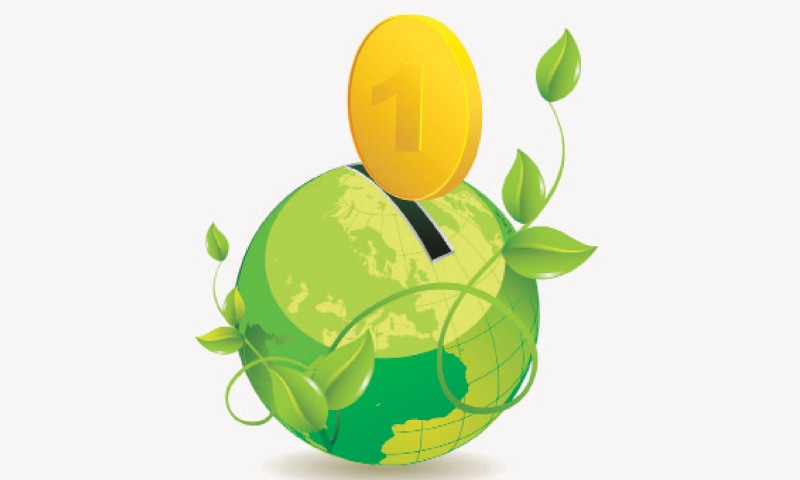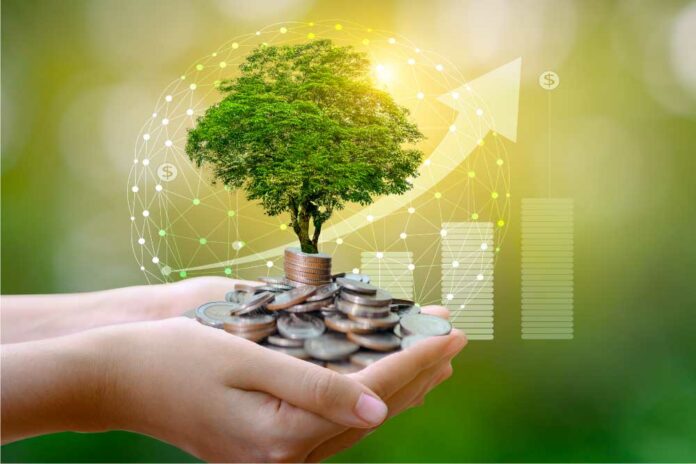Green Banking - A Strategic Approach To Environmental Sustainability
Explore the sustainable and eco-friendly initiatives in the financial world with our comprehensive guide to green banking. Stay informed about the latest trends and practices in sustainable finance for a more environmentally conscious approach to banking.
Author:Dexter CookeReviewer:Darren McphersonJan 18, 20244K Shares69K Views

In a world increasingly focused on environmental sustainability, the concept of green bankingemerges as a beacon of responsible finance. Green Banking goes beyond traditional banking practices, emphasizing a commitment to eco-friendly initiatives and sustainable development.
Financial institutions are recognizing the urgent need to align their operations with environmental goals, promoting renewable energy, and supporting projects that mitigate climate change.
This paradigm shift in the banking sector not only addresses environmental concerns but also sets the stage for a more responsible and ethical approach to financial services. Join us on a journey into the realm of Green Banking, where financial institutions are becoming catalysts for positive change, fostering a harmonious balance between economic growth and ecological well-being.
What Are Green Banks?
Green Banks are financial institutions dedicated to driving sustainable and environmentally friendly initiatives within the banking sector. Unlike traditional banks, Green Banks prioritize investments and projects that promote renewable energy, energy efficiency, and overall environmental responsibility.
These institutions act as catalysts for change, leveraging financial resources to support projects that address climate change, reduce carbon emissions, and contribute to a more sustainable future.
Green Banks play a pivotal role in bridging the gap between the financial industry and the urgent need for environmental stewardship. Their core mission involves providing financial support and expertise to projects that may be considered too risky or innovative by conventional banks. This includes funding for renewable energy infrastructure, energy-efficient building projects, and sustainable transportation initiatives.
These banks often collaborate with governments, private entities, and non-profit organizations to create a collaborative ecosystem for sustainable finance. By offering a range of financial tools such as loans, grants, and guarantees, Green Banks empower businesses and communities to embrace green technologies and practices.
Green Banks go beyond profit-driven motives, aligning their objectives with the broader goal of mitigating climate change and fostering a harmonious relationship between economic development and environmental conservation. As the world faces increasing environmental challenges, Green Banks stand as beacons of hope, leading the financial sector toward a more sustainable and ecologically responsible future.
Why Is Green Banking Important?
It is becoming obvious that sustainable investment techniques are critical to combating climate change. The Intergovernmental Panel on Climate Change (IPCC)predicts that our planet will warm by 3 to 5 degrees Celsius by 2100 if businesses continue to operate as usual. If left unchecked, extreme weather events might cost hundreds of billions of dollars and claim countless lives.
Within this framework, businesses must do their part to minimize greenhouse gas emissions through their operations. This is especially true for the world's 60 largest private banks, which, according to a Banktrack analysis, invested an astounding $3.8 trillion in coal, oil, and natural gas projects between 2016 and 2020. The development of the fossil fuel industry may jeopardize the attainment of the Paris Climate Agreement targets.
Fortunately, the adoption of objectives of green banking by numerous large institutions in recent years suggests that a renewable energy-based economy could emerge shortly. As the benefits of climate resilience and clean energy become increasingly apparent, more institutions may choose to address climate concerns rather than maximize profits.
Benefits Of Green Banking
Several large financial organizations have begun to implement green banking concepts, as more clients demand greater environmental responsibility from banks.
What is green banking? Green banking gives a bank a competitive advantage by encouraging it to participate in sustainable, low-carbon industries that generate long-term profitability and attract eco-conscious investors, such as renewable energy.
Willing To Take Risks That Matter
Green banks differ from their competitors in that they are willing to take risks on important sustainable energy projects, industries, and goods. They make investment decisions based on environmental, social, and governance (ESG) factors and look for new carbon-resilient technologies that deliver both economic and societal value. Electric vehicles, smart power grids, and renewable energy systems are among the risky breakthroughs that green banks typically invest in.
As a result of these measures, green banks no longer finance environmentally damaging businesses like fossil fuels.
Potential To Scale With Additional Funding
Green banks also play an important role in scaling up critical low-carbon technologies, allowing them to get additional finance from government agencies and environmentally aware investors.
This cash allows them to expand their activities and pursue additional national and global climate goals. It also enables them to hire more technical specialists to supplement their investments in climate-friendly technologies.
Strong Accountability
What distinguishes green banks from major banks is their dedication to accountability. Several green banks issue annual financial reports to keep investors and consumers up to date on their investments and carbon emissions. This kind of transparency fosters trust between the Green Bank and its stakeholders.
Furthermore, green banking urges banks to have robust governance systems that are responsive to climate change. A climate accountability culture encourages green banks to invest in initiatives with favorable social consequences over time.
Focused On Reducing Carbon Footprints
Green banks work toward the aims of the Paris Agreement by redirecting financial flows to ecologically beneficial projects. They have helped to build a climate-resilient infrastructure that decreases carbon emissions. Green banks are driving an increase in community adoption of low-carbon technology like household geothermal power systems, which, if expanded, can help bring the globe toward net-zero emissions.
To achieve a low-carbon future, we require additional funding from green banks to rapidly boost the availability of community-level renewable energy systems.
What To Look For In An Eco-Friendly Bank?
- Sustainable Practices -When considering an eco-friendly bank, the first aspect to examine is the institution's commitment to sustainable practices. Evaluate whether the bank actively promotes environmentally responsible initiatives, such as investments in renewable energy projects, reduction of paper usage, and support for sustainable development. A genuine eco-friendly bank will align its operational practices with a commitment to minimizing its ecological footprint.
- Green Banking Policies -Delve into the specific green banking policies that the institution has in place. Look for transparent policies outlining their commitment to environmental sustainability, ethical lending practices, and adherence to international standards for responsible banking. A bank with well-defined green policies demonstrates a dedication to integrating eco-friendly practices into its core operations.
- Renewable Energy Investments -An eco-friendly bank should actively invest in renewable energy projects. Assess the bank's portfolio to see if it includes financing for solar, wind, or other sustainable energy initiatives. Supporting the transition to clean energy sources is a key indicator of a bank's commitment to combating climate change and promoting a greener future.
- Eco-Friendly Products -Examine the range of financial products offered by the bank. An eco-friendly bank should provide customers with options such as green loans for energy-efficient home improvements, environmentally conscious investment portfolios, or sustainable credit cards that contribute to environmental causes. The availability of these products reflects the institution's dedication to providing eco-conscious financial solutions.
- Carbon Neutrality Initiatives -Look for initiatives aimed at achieving carbon neutrality. An eco-friendly bank may implement strategies to offset its carbon emissions, invest in carbon offset projects, or actively work toward reducing its environmental impact. Commitment to carbon neutrality demonstrates a holistic approach to environmental responsibility.
- Community Engagement -Assess the bank's involvement in community-based environmental initiatives. An eco-friendly bank actively engages with local communities, supporting projects that promote environmental education, conservation, and sustainable development. Community engagement reflects a bank's commitment to making a positive impact beyond its own operations.
- Transparency and Reporting -Consider the transparency of the bank regarding its environmental practices. Look for regular sustainability reports, detailing the institution's environmental performance, goals, and achievements. Transparency is a crucial element, indicating the bank's willingness to be held accountable for its eco-friendly commitments.
- Certification and Recognitions -Check if the bank holds certifications or has received recognitions for its eco-friendly practices. Certifications like the Leadership in Energy and Environmental Design (LEED) or recognition from environmental organizations signify a credible commitment to sustainability.
Green Banking - Simple Steps To Get Started Today
One of the simplest methods to lessen your carbon footprint is to conduct business with a green bank. The appropriate green banking partner can help you save, invest, and donate money to benefit the environment.
Paperless Billing
The first and easiest thing you can do to help the environment is to stop using paper bank statements and bills. This helps reduce the quantity of paper used by your bank while also reducing clutter in your house. Electronic bank statements can be requested from the bank at nearly any time, eliminating the need to wait for them to arrive in the mail.
According to studies, switching to paperless can save the average household up to 9 paper bills every month. Over the course of a year, a family might minimize their carbon emissions by approximately 3kg.
Mobile Banking From Home
Customers can now complete transactions without having to drive to a branch. They may easily do it from the comfort of their own home or workplace, saving them money and reducing their carbon footprint. Online transactions are generally faster and safer.
Furthermore, online banking allows brick-and-mortar banks to reduce the number of locations they operate and allocate shorter banking hours to each branch. This saves them money on their energy bills and reduces pressure on the power grid.
Automate Your Commitment To Sustainability
Another advantage of online banking over traditional banking is the ability to automate charity payments to environmental organizations. Several banks allow consumers to make pre-authorized contributions, which are monthly monetary pledges to charity of their choice, using direct debit or credit card payments.
Aspiration goes a step further, allowing customers to not only set up automatic recurring gifts to organizations, but also to help plant trees with each purchase. When our clients purchase gas for their vehicles, our Planet Protection program evaluates the carbon footprint of the gas and automatically plants trees to help offset the carbon impact.
Similarly, our Plant Your Change initiative rounds up each transaction to the next dollar and plants trees with the leftover change.
Leave Your Bank For A More Ethical Alternative
Finally, the greatest method to bank responsibly is to avoid dishonest large banks in favor of more ethical options. Socially responsible ecobanks are far more likely than typical banks to be open about their investment and lending practices. The majority of them will agree not to invest in fossil fuels, weapons industries, or private prisons.
With a green bank account, you'll have access to eco-friendly goods that will help you develop your wealth while lowering your carbon footprint. At Aspiration, we offer accounts that pay up to 5.00% APY on savings ($10,000 balance with a spend requirement) with no ATM, overdraft, or deposit fees.
What Is The Future Of Green Banking?
The green revolution may still be in its early stages. However, it is rising rapidly enough to potentially replace traditional fossil fuel investment techniques.
Just a decade ago, prominent environmentalists urged financial institutions to withdraw from oil, natural gas, shale, and tar sands projects. Currently, almost $14.5 trillion has been contributed to the fossil fuel divestment movement.
Green banksare emerging as viable alternatives to regular banks, particularly as customers increasingly question the long-term feasibility of fossil fuels as an energy source.
The continuing stigmatization of fossil fuels may result in a reduction in capital flows to fossil fuel businesses, which might eventually lead to the industry's extinction and increased adoption of clean energy technology.
Green Banking - FAQs
Are There Any Specific Criteria For A Bank To Be Considered "green"?
Yes, Green Banking involves adherence to specific criteria such as promoting renewable energy, reducing waste, and supporting environmentally responsible projects.
What Role Do Customers Play In Green Banking?
Customers play a crucial role by choosing environmentally conscious banks, supporting green financial products, and advocating for sustainable banking practices.
How Do Green Banking Initiatives Impact The Economy?
Green Banking initiatives can positively impact the economy by fostering sustainable development, creating green jobs, and mitigating the long-term financial risks associated with environmental degradation.
Are There Global Standards For Green Banking Practices?
Yes, several international organizations and initiatives, such as the Equator Principles and the United Nations Principles for Responsible Banking, set global standards for Green Banking practices.
What Are Some Examples Of Green Banking Projects?
Examples include financing solar and wind energy projects, supporting energy-efficient building construction, and funding initiatives focused on sustainable agriculture and forestry.
Conclusion About Green Banking
Green banking stands as a testament to the financial sector's evolving role in fostering a sustainable future. As we traverse the landscape of environmentally conscious banking, it becomes evident that these initiatives are not just altruistic endeavors but strategic investments in a healthier planet.
The commitment to renewable energy, eco-friendly practices, and socially responsible financing showcases a paradigm shift towards a more sustainable and ethical financial industry.
By choosing Green Banking, individuals and institutions contribute to a collective effort to combat climate change and preserve our planet for future generations. As the momentum for green finance grows, the transformative impact on both the banking sector and the environment promises a brighter and more sustainable future for all.

Dexter Cooke
Author
Dexter Cooke is an economist, marketing strategist, and orthopedic surgeon with over 20 years of experience crafting compelling narratives that resonate worldwide.
He holds a Journalism degree from Columbia University, an Economics background from Yale University, and a medical degree with a postdoctoral fellowship in orthopedic medicine from the Medical University of South Carolina.
Dexter’s insights into media, economics, and marketing shine through his prolific contributions to respected publications and advisory roles for influential organizations.
As an orthopedic surgeon specializing in minimally invasive knee replacement surgery and laparoscopic procedures, Dexter prioritizes patient care above all.
Outside his professional pursuits, Dexter enjoys collecting vintage watches, studying ancient civilizations, learning about astronomy, and participating in charity runs.

Darren Mcpherson
Reviewer
Darren Mcpherson brings over 9 years of experience in politics, business, investing, and banking to his writing. He holds degrees in Economics from Harvard University and Political Science from Stanford University, with certifications in Financial Management.
Renowned for his insightful analyses and strategic awareness, Darren has contributed to reputable publications and served in advisory roles for influential entities.
Outside the boardroom, Darren enjoys playing chess, collecting rare books, attending technology conferences, and mentoring young professionals.
His dedication to excellence and understanding of global finance and governance make him a trusted and authoritative voice in his field.
Latest Articles
Popular Articles

